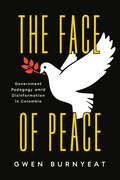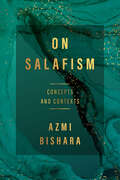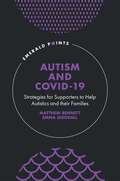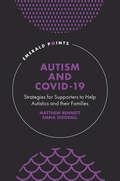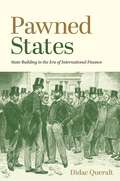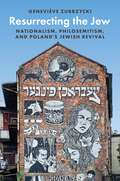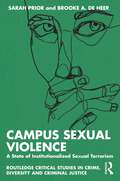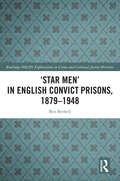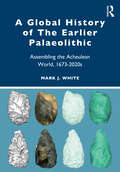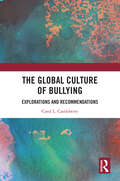- Table View
- List View
The Face of Peace: Government Pedagogy amid Disinformation in Colombia
by Gwen BurnyeatA multi-scale ethnography of government pedagogy in Colombia and its impact on peace. Colombia’s 2016 peace agreement with the FARC guerrillas sought to end fifty years of war and won President Juan Manuel Santos the Nobel Peace Prize. Yet Colombian society rejected it in a polarizing referendum, amid an emotive disinformation campaign. Gwen Burnyeat joined the Office of the High Commissioner for Peace, the government institution responsible for peace negotiations, to observe and participate in an innovative “peace pedagogy” strategy to explain the agreement to Colombian society. Burnyeat’s multi-scale ethnography reveals the challenges government officials experienced communicating with skeptical audiences and translating the peace process for public opinion. She argues that the fatal flaw in the peace process lay in government-society relations, enmeshed in culturally liberal logics and shaped by the politics of international donors. The Face of Peace offers the Colombian case as a mirror to the global crisis of liberalism, shattering the fantasy of rationality that haunts liberal responses to “post-truth” politics.
Laughing with the Trickster: On Sex, Death, and Accordions (The CBC Massey Lectures)
by Tomson HighwayBrilliant, jubilant insights into the glory and anguish of life from one of the world’s most treasured Indigenous creators. Trickster is zany, ridiculous. The ultimate, over-the-top, madcap fool. Here to remind us that the reason for existence is to have a blast and to laugh ourselves silly. Celebrated author and playwright Tomson Highway brings his signature irreverence to an exploration of five themes central to the human condition: language, creation, sex and gender, humour, and death. A comparative analysis of Christian, classical, and Cree mythologies reveals their contributions to Western thought, life, and culture—and how North American Indigenous mythologies provide unique, timeless solutions to our modern problems. Highway also offers generous personal anecdotes, including accounts of his beloved accordion-playing, caribou-hunting father, and plentiful Trickster stories as curatives for the all-out unhappiness caused by today’s patriarchal, colonial systems. Laugh with the legendary Tomson Highway as he illuminates a healing, hilarious way forward.
On Salafism: Concepts and Contexts (Stanford Studies in Middle Eastern and Islamic Societies and Cultures)
by Azmi BisharaOn Salafism offers a compelling new understanding of this phenomenon, both its development and contemporary manifestations. Salafism became associated with fundamentalism when the 9/11 Commission used it to explain the terror attacks and has since been connected with the violence of the so-called Islamic State. With this book, Azmi Bishara critically deconstructs claims of continuity between early Islam and modern militancy and makes a counterargument: Salafism is a wholly modern construct informed by specific sociopolitical contexts. Bishara offers a sophisticated account of various movements—such as Wahabbism and Hanbalism—frequently collapsed into simplistic understandings of Salafism. He distinguishes reformist from regressive Salafism, and examines patterns of modernization in the development of contemporary Islamic political movements and associations. In deconstructing the assumptions of linear continuity between traditional and contemporary movements, Bishara details various divergences in both doctrine and context of modern Salafisms, plural. On Salafism is a crucial read for those interested in Islamism, jihadism, and Middle East politics and history.
On Salafism: Concepts and Contexts (Stanford Studies in Middle Eastern and Islamic Societies and Cultures)
by Azmi BisharaOn Salafism offers a compelling new understanding of this phenomenon, both its development and contemporary manifestations. Salafism became associated with fundamentalism when the 9/11 Commission used it to explain the terror attacks and has since been connected with the violence of the so-called Islamic State. With this book, Azmi Bishara critically deconstructs claims of continuity between early Islam and modern militancy and makes a counterargument: Salafism is a wholly modern construct informed by specific sociopolitical contexts. Bishara offers a sophisticated account of various movements—such as Wahabbism and Hanbalism—frequently collapsed into simplistic understandings of Salafism. He distinguishes reformist from regressive Salafism, and examines patterns of modernization in the development of contemporary Islamic political movements and associations. In deconstructing the assumptions of linear continuity between traditional and contemporary movements, Bishara details various divergences in both doctrine and context of modern Salafisms, plural. On Salafism is a crucial read for those interested in Islamism, jihadism, and Middle East politics and history.
Autism and COVID-19: Strategies for Supporters to Help Autistics and Their Families (Emerald Points)
by Matthew Bennett Emma GoodallThe COVID-19 pandemic has had a profound and potentially ever-lasting impact on our economy, society, and the way that we live. In response to this pandemic there has been a plethora of research published about COVID-19. However, within this fast-growing body of literature there are only scant references made to the impact that this pandemic has had on autistics, their families, and the healthcare professionals who support autistics. Autism and COVID-19 is a concise summary of the research, bridging the gaps in our knowledge about autism and the COVID-19 pandemic. Bennett and Goodall address vaccine hesitancy among autistics and parents raising autistic children, the experiences of autistics living with COVID-19 disease and parenting an autistic child during the COVID-19 pandemic, synthesising the data about the COVID-19 pandemic from the perspective of autistic, their families, and those that provide autistics with medical assistance. Autism and COVID-19 both reviews the existing literature and presents new findings from a survey distributed to autistics and parents of autistics during the pandemic, all of which offer a unique and timely contribution to researchers, academics, practitioners, and those working with autistics and their families.
Autism and COVID-19: Strategies for Supporters to Help Autistics and Their Families (Emerald Points)
by Matthew Bennett Emma GoodallThe COVID-19 pandemic has had a profound and potentially ever-lasting impact on our economy, society, and the way that we live. In response to this pandemic there has been a plethora of research published about COVID-19. However, within this fast-growing body of literature there are only scant references made to the impact that this pandemic has had on autistics, their families, and the healthcare professionals who support autistics. Autism and COVID-19 is a concise summary of the research, bridging the gaps in our knowledge about autism and the COVID-19 pandemic. Bennett and Goodall address vaccine hesitancy among autistics and parents raising autistic children, the experiences of autistics living with COVID-19 disease and parenting an autistic child during the COVID-19 pandemic, synthesising the data about the COVID-19 pandemic from the perspective of autistic, their families, and those that provide autistics with medical assistance. Autism and COVID-19 both reviews the existing literature and presents new findings from a survey distributed to autistics and parents of autistics during the pandemic, all of which offer a unique and timely contribution to researchers, academics, practitioners, and those working with autistics and their families.
Pawned States: State Building in the Era of International Finance (The Princeton Economic History of the Western World #110)
by Didac QueraltHow foreign lending weakens emerging nationsIn the nineteenth century, many developing countries turned to the credit houses of Europe for sovereign loans to balance their books and weather major fiscal shocks such as war. This reliance on external public finance offered emerging nations endless opportunities to overcome barriers to growth, but it also enabled rulers to bypass critical stages in institution building and political development. Pawned States reveals how easy access to foreign lending at early stages of state building has led to chronic fiscal instability and weakened state capacity in the developing world.Drawing on a wealth of original data to document the rise of cheap overseas credit between 1816 and 1913, Didac Queralt shows how countries in the global periphery obtained these loans by agreeing to “extreme conditionality,” which empowered international investors to take control of local revenue sources in cases of default, and how foreclosure eroded a country’s tax base and caused lasting fiscal disequilibrium. Queralt goes on to combine quantitative analysis of tax performance between 1816 and 2005 with qualitative historical analysis in Latin America, Asia, Africa, and the Middle East, illustrating how overreliance on external capital by local leaders distorts their incentives to expand tax capacity, articulate power-sharing institutions, and strengthen bureaucratic apparatus.Panoramic in scope, Pawned States sheds needed light on how early and easy access to external finance pushes developing nations into trajectories characterized by fragile fiscal institutions and autocratic politics.
Pawned States: State Building in the Era of International Finance (The Princeton Economic History of the Western World #110)
by Didac QueraltHow foreign lending weakens emerging nationsIn the nineteenth century, many developing countries turned to the credit houses of Europe for sovereign loans to balance their books and weather major fiscal shocks such as war. This reliance on external public finance offered emerging nations endless opportunities to overcome barriers to growth, but it also enabled rulers to bypass critical stages in institution building and political development. Pawned States reveals how easy access to foreign lending at early stages of state building has led to chronic fiscal instability and weakened state capacity in the developing world.Drawing on a wealth of original data to document the rise of cheap overseas credit between 1816 and 1913, Didac Queralt shows how countries in the global periphery obtained these loans by agreeing to “extreme conditionality,” which empowered international investors to take control of local revenue sources in cases of default, and how foreclosure eroded a country’s tax base and caused lasting fiscal disequilibrium. Queralt goes on to combine quantitative analysis of tax performance between 1816 and 2005 with qualitative historical analysis in Latin America, Asia, Africa, and the Middle East, illustrating how overreliance on external capital by local leaders distorts their incentives to expand tax capacity, articulate power-sharing institutions, and strengthen bureaucratic apparatus.Panoramic in scope, Pawned States sheds needed light on how early and easy access to external finance pushes developing nations into trajectories characterized by fragile fiscal institutions and autocratic politics.
Resurrecting the Jew: Nationalism, Philosemitism, and Poland’s Jewish Revival (Princeton Studies in Cultural Sociology #18)
by Geneviève ZubrzyckiAn in-depth look at why non-Jewish Poles are trying to bring Jewish culture back to life in Poland todaySince the early 2000s, Poland has experienced a remarkable Jewish revival, largely driven by non-Jewish Poles with a passionate new interest in all things Jewish. Klezmer music, Jewish-style restaurants, kosher vodka, and festivals of Jewish culture have become popular, while new museums, memorials, Jewish studies programs, and Holocaust research centers reflect soul-searching about Polish-Jewish relations before, during, and after the Holocaust. In Resurrecting the Jew, Geneviève Zubrzycki examines this revival and asks what it means to try to bring Jewish culture back to life in a country where 3 million Jews were murdered and where only about 10,000 Jews now live.Drawing on a decade of participant-observation in Jewish and Jewish-related organizations in Poland, a Birthright trip to Israel with young Polish Jews, and more than a hundred interviews with Jewish and non-Jewish Poles engaged in the Jewish revival, Resurrecting the Jew presents an in-depth look at Jewish life in Poland today. The book shows how the revival has been spurred by progressive Poles who want to break the association between Polishness and Catholicism, promote the idea of a multicultural Poland, and resist the Far Right government. The book also raises urgent questions, relevant far beyond Poland, about the limits of performative solidarity and empathetic forms of cultural appropriation.
Resurrecting the Jew: Nationalism, Philosemitism, and Poland’s Jewish Revival (Princeton Studies in Cultural Sociology #18)
by Geneviève ZubrzyckiAn in-depth look at why non-Jewish Poles are trying to bring Jewish culture back to life in Poland todaySince the early 2000s, Poland has experienced a remarkable Jewish revival, largely driven by non-Jewish Poles with a passionate new interest in all things Jewish. Klezmer music, Jewish-style restaurants, kosher vodka, and festivals of Jewish culture have become popular, while new museums, memorials, Jewish studies programs, and Holocaust research centers reflect soul-searching about Polish-Jewish relations before, during, and after the Holocaust. In Resurrecting the Jew, Geneviève Zubrzycki examines this revival and asks what it means to try to bring Jewish culture back to life in a country where 3 million Jews were murdered and where only about 10,000 Jews now live.Drawing on a decade of participant-observation in Jewish and Jewish-related organizations in Poland, a Birthright trip to Israel with young Polish Jews, and more than a hundred interviews with Jewish and non-Jewish Poles engaged in the Jewish revival, Resurrecting the Jew presents an in-depth look at Jewish life in Poland today. The book shows how the revival has been spurred by progressive Poles who want to break the association between Polishness and Catholicism, promote the idea of a multicultural Poland, and resist the Far Right government. The book also raises urgent questions, relevant far beyond Poland, about the limits of performative solidarity and empathetic forms of cultural appropriation.
Campus Sexual Violence: A State of Institutionalized Sexual Terrorism
by Sarah Prior Brooke A. de HeerCampus Sexual Violence: A State of Institutionalized Sexual Terrorism conceptualizes sexual violence on college campuses as a form of sexual terrorism, arguing that institutional compliance and inaction within the neoliberal university perpetuate a system of sexual terrorism. Using a sexual terrorism framework, the authors examine a myriad of examples of campus sexual violence with an intersectional lens and explore the role of the institution and the influence of neoliberalism in undermining sexual violence prevention efforts. The book utilizes Carole Sheffield’s five components of sexual terrorism (ideology, propaganda, amorality, perceptions of the perpetrator, and voluntary compliance) to describe how the "ivory tower stereotype" and adoption of neoliberal values into education contribute to an environment where victimization is painfully common. Cases such as those from Michigan State University and Baylor University are used as examples to highlight institutional culpability and neoliberal value systems within higher education, as well as illustrating the pervasiveness of rape culture that contributes to a system of sexual terrorism. Crucially, the book focuses on systems of inequality and oppression, and uses an intersectional perspective that recognizes victimization experienced by multiple marginalized groups including women, LGBTQ+, and racially minoritized people. Building on campus violence research and institutional harm research, the authors define campus sexual violence as a serious social problem based in structural inequality and advocate for civic responsibility at the institutional level and the development of institutional advocates. Weaving together theoretical and practical perspectives, the book will be of great interest to students and scholars of sociology, criminal justice, women’s and gender studies, social/political policy, victimology, and education. It will also be of use to those working in higher education administration and other student life and student health professions.
The Skeptics' Guide to the Future
by Steven NovellaPre-order now: the new book from the bestselling authors and hosts of the wildy popular 'The Skeptics Guide to the Universe'__________Our predictions of the future are a wild fantasy, inextricably linked to our present hopes and fears, biases and ignorance. Whether they be the outlandish leaps predicted in the 1920s, like multi-purpose utility belts with climate control capabilities and planes the size of luxury cruise ships, or the forecasts of the '60s, which didn't anticipate the sexual revolution or women's liberation, the path to the present is littered with failed predictions and incorrect estimations.The best we can do is try to absorb from futurism's checkered past, perhaps learning to do a little better.In The Skeptics' Guide To The Future, Steven Novella and his co-authors build upon the work of futurists of the past by examining what they got right, what they got wrong, and how they came to those conclusions. By exploring the pitfalls of each era, they give their own speculations about the distant future, transformed by unbelievable technology ranging from genetic manipulation to artificial intelligence and quantum computing. Applying their trademark skepticism, they carefully extrapolate upon each scientific development, leaving no stone unturned as they lay out a vision for the future of tomorrow.__________
The Rise of the Infrastructure State: How US–China Rivalry Shapes Politics and Place Worldwide
by Seth Schindler and Jessica DiCarloTensions between the US and China have escalated as both powers seek to draw countries into their respective political and economic orbits by financing and constructing infrastructure. Wide-ranging and even-handed, this book offers a fresh interpretation of the territorial logic of US–China rivalry, and explores what it means for countries across Eurasia, Africa, and Latin America. The chapters demonstrate that many countries navigate the global infrastructure boom by articulating novel spatial objectives and implementing political and economic reforms. By focusing on people and places worldwide, this book broadens perspectives on the US–China rivalry beyond bipolarity. It is an essential guide to 21st century politics.
The Rise of the Infrastructure State: How US–China Rivalry Shapes Politics and Place Worldwide
by Seth Schindler Jessica DiCarloTensions between the US and China have escalated as both powers seek to draw countries into their respective political and economic orbits by financing and constructing infrastructure. Wide-ranging and even-handed, this book offers a fresh interpretation of the territorial logic of US–China rivalry, and explores what it means for countries across Eurasia, Africa, and Latin America. The chapters demonstrate that many countries navigate the global infrastructure boom by articulating novel spatial objectives and implementing political and economic reforms. By focusing on people and places worldwide, this book broadens perspectives on the US–China rivalry beyond bipolarity. It is an essential guide to 21st century politics.
Campus Sexual Violence: A State of Institutionalized Sexual Terrorism
by Sarah Prior Brooke A. de HeerCampus Sexual Violence: A State of Institutionalized Sexual Terrorism conceptualizes sexual violence on college campuses as a form of sexual terrorism, arguing that institutional compliance and inaction within the neoliberal university perpetuate a system of sexual terrorism. Using a sexual terrorism framework, the authors examine a myriad of examples of campus sexual violence with an intersectional lens and explore the role of the institution and the influence of neoliberalism in undermining sexual violence prevention efforts. The book utilizes Carole Sheffield’s five components of sexual terrorism (ideology, propaganda, amorality, perceptions of the perpetrator, and voluntary compliance) to describe how the "ivory tower stereotype" and adoption of neoliberal values into education contribute to an environment where victimization is painfully common. Cases such as those from Michigan State University and Baylor University are used as examples to highlight institutional culpability and neoliberal value systems within higher education, as well as illustrating the pervasiveness of rape culture that contributes to a system of sexual terrorism. Crucially, the book focuses on systems of inequality and oppression, and uses an intersectional perspective that recognizes victimization experienced by multiple marginalized groups including women, LGBTQ+, and racially minoritized people. Building on campus violence research and institutional harm research, the authors define campus sexual violence as a serious social problem based in structural inequality and advocate for civic responsibility at the institutional level and the development of institutional advocates. Weaving together theoretical and practical perspectives, the book will be of great interest to students and scholars of sociology, criminal justice, women’s and gender studies, social/political policy, victimology, and education. It will also be of use to those working in higher education administration and other student life and student health professions.
Empire and Popular Culture: Volume I
by John GriffithsFrom 1830, the British Empire began to permeate the domestic culture of Empire nations in many ways. This, the fourth volume of Empire and Popular Culture, explores the representation of the Empire in popular media such as newspapers, contemporary magazines and journals and in literature such as novels, works of non-fiction, in poems and ballads.
Empire and Popular Culture
by John GriffithsFrom 1830, the British Empire began to permeate the domestic culture of Empire nations in many ways. This, the fourth volume of Empire and Popular Culture, explores the representation of the Empire in popular media such as newspapers, contemporary magazines and journals and in literature such as novels, works of non-fiction, in poems and ballads.
‘Star Men’ in English Convict Prisons, 1879-1948 (Routledge SOLON Explorations in Crime and Criminal Justice Histories)
by Ben BethellThis book tells the story of the star class, a segregated division for first offenders in English convict prisons; known informally as ‘star men’, convicts assigned to the division were identified by a red star sewn to their uniforms. ‘Star Men’ in English Convict Prisons, 1879–1948 investigates the origins of the star class in the years leading up to its establishment in 1879, and charts its subsequent development during the late-Victorian, Edwardian, and interwar decades. To what extent did the star class serve to shield ‘gentleman convicts’ from their social inferiors and allow them a measure of privilege? What was the precise nature of the ‘contamination’ by which they and other ‘accidental criminals’ were believed to be threatened? And why, for the first twenty years of its existence, were first offenders convicted of ‘unnatural crimes’ barred from the division? To explore these questions, the book considers the making and implementation of penal policy by senior civil servants and prison administrators, and the daily life and work of prisoners at policy’s receiving end. It re-examines evolving notions of criminality, the competing aims of reformation and deterrence, and the role and changing nature of prison labour. Along the way, readers will encounter an array of star men, including arsonists, abortionists, sex offenders and reprieved murderers, disgraced bankers, light-fingered postmen, bent solicitors, and perjuring policemen. Taking a fresh look at English prison history through converging lenses of class, sexuality, and labour, ‘Star Men’ in English Convict Prisons, 1879-1948 will be of great interest to penal historians and historical criminologists, and to scholars working on related aspects of modern British history.
You Gotta Be You: How to Embrace This Messy Life and Step Into Who You Really Are
by Brandon Kyle GoodmanYOU ARE ENOUGH EXACTLY AS YOU ARE. From the time we&’re born, a litany of do&’s and don&’ts are placed on us by our families, our communities, and society. We&’re required to fit into boxes based on our race, gender, sexuality, and other parts of our identities, being told by others how we should behave, who we should date, or what we should be interested in. For so many of us, those boxes begin to feel like shackles when we realize they don&’t fit our unique shape, yet we keep trying because we crave acceptance and validation. But is &“fitting in&” worth the time, energy, and suffering? Actor, writer, and activist Brandon Kyle Goodman says, Hell no it ain&’t! As a Black nonbinary, queer person in a dark-skinned 6&’1&”, 180-pound male body born into a religious immigrant household, Brandon knows the pain of having to hide one&’s true self, the work of learning to love that true self, and the freedom of finally being your true self. In You Gotta Be You, Brandon affectionately challenges you to consider, &“Who would I be if society never got its hands on me?&” This question set Brandon on a mission to dropkick societal shackles by unlearning all the things he was told he should be in order to step into who he really is. It required him to reexamine messy but ultimately defining moments in his life—his first time being followed in a store, navigating his mother&’s born-again Christianity, and regretfully using soap as lube (yes, you read that right!)—to find the lessons that would guide him to his most authentic self. Compassionate and soulful, funny and revealing, You Gotta Be You is an unapologetic call to self-freedom. It&’s about turning rejection (from others and yourself) into a roadmap to self-love. It&’s a guide to setting boundaries and fostering self-growth. And most importantly, it&’s an affirmation that we are enough exactly as we are.
The Routledge Companion to Sinhala Fiction from Post-War Sri Lanka: Resistance and Reconfiguration
by Madhubhashini Disanayaka RatnayakeThis companion presents a critical collection of Sinhala resistance literature from Sri Lanka. It includes translated short stories and excerpts from Sinhala novels, written after the civil war in the country. Featuring national award-winning writers, the selected texts share a common theme of resistance as the writers write against an exclusivist nationalism that was propagated through mass media and platforms of party politics in Sri Lanka during the war. The volume addresses crucial issues such as the fate of civilians in war, the role of religion in Sri Lankan polity, media censorship, the experience of women in war, as well as the current education system and youth problems in present day Sri Lanka. It highlights an alternate discourse that runs among the ethnic Sinhala group and contributes to the overall movement towards peace and reconciliation among the different ethnic communities in Sri Lanka. A unique addition to the growing oeuvre of translated Sinhala literature, the companion will be indispensable to students, scholars, and researchers of ethnic studies, war and peace studies, peace and conflict studies, literature, cultural studies, political sociology, and South Asian studies, particularly those interested in Sri Lankan literature.
The Routledge Companion to Sinhala Fiction from Post-War Sri Lanka: Resistance and Reconfiguration
by Madhubhashini Disanayaka RatnayakeThis companion presents a critical collection of Sinhala resistance literature from Sri Lanka. It includes translated short stories and excerpts from Sinhala novels, written after the civil war in the country. Featuring national award-winning writers, the selected texts share a common theme of resistance as the writers write against an exclusivist nationalism that was propagated through mass media and platforms of party politics in Sri Lanka during the war. The volume addresses crucial issues such as the fate of civilians in war, the role of religion in Sri Lankan polity, media censorship, the experience of women in war, as well as the current education system and youth problems in present day Sri Lanka. It highlights an alternate discourse that runs among the ethnic Sinhala group and contributes to the overall movement towards peace and reconciliation among the different ethnic communities in Sri Lanka. A unique addition to the growing oeuvre of translated Sinhala literature, the companion will be indispensable to students, scholars, and researchers of ethnic studies, war and peace studies, peace and conflict studies, literature, cultural studies, political sociology, and South Asian studies, particularly those interested in Sri Lankan literature.
A Global History of The Earlier Palaeolithic: Assembling the Acheulean World, 1673–2020s
by Mark J. WhiteThis book tells the story of both the ancient humans who made handaxes and the thoughts and ideas of scholars who have spent their lives trying to understand them. Beginning with the earliest known finds, this volume provides a linear and thematic account of the history of the Old Stone Age, or Palaeolithic period, covering major discoveries, interpretations and debates worldwide; a story that takes us from the embers of the Great Fire of London to the beginning of the Covid-19 pandemic. It offers a comprehensive and unique history of archaeological theory and interpretation, seeking to explain how we know what we know about the deep past, and how ideas about it have changed over time, reflecting both scientific and societal change. At its heart lies the quest for an answer to a most curious and sometimes beautiful tool ever made – the handaxe. While focused on the Earlier Palaeolithic period, the book provides a readable account of how ideas about the prehistoric past generally were formed and altered, showing how the wider discipline came to be dominated by a succession of different theoretical ‘paradigms’, each seeking different answers from the same data set. Serving a dual purpose as a historical narrative and as a reference source, this book will be of interest to all students and researchers interested in deep human prehistory and evolution, archaeological theory and the history of archaeology.
A Global History of The Earlier Palaeolithic: Assembling the Acheulean World, 1673–2020s
by Mark J. WhiteThis book tells the story of both the ancient humans who made handaxes and the thoughts and ideas of scholars who have spent their lives trying to understand them. Beginning with the earliest known finds, this volume provides a linear and thematic account of the history of the Old Stone Age, or Palaeolithic period, covering major discoveries, interpretations and debates worldwide; a story that takes us from the embers of the Great Fire of London to the beginning of the Covid-19 pandemic. It offers a comprehensive and unique history of archaeological theory and interpretation, seeking to explain how we know what we know about the deep past, and how ideas about it have changed over time, reflecting both scientific and societal change. At its heart lies the quest for an answer to a most curious and sometimes beautiful tool ever made – the handaxe. While focused on the Earlier Palaeolithic period, the book provides a readable account of how ideas about the prehistoric past generally were formed and altered, showing how the wider discipline came to be dominated by a succession of different theoretical ‘paradigms’, each seeking different answers from the same data set. Serving a dual purpose as a historical narrative and as a reference source, this book will be of interest to all students and researchers interested in deep human prehistory and evolution, archaeological theory and the history of archaeology.
The Global Culture of Bullying: Explorations and Recommendations
by Carol CastleberryThis book explicates “bullying” as a concept and as a social and cultural phenomenon that has become a defining reality of the times in which we live. The author begins in the arena where it is first, and most acutely individually, experienced—in school—and expands to other institutions and areas of social life—the family, the workplace, and the local, national, and international spheres, extending the concept of bullying to the global arena to uncover the social and institutional root causes of the extreme forms of bullying such as trafficking, torture, terrorism, and genocide. The book discusses the steps taken to address these issues and analyzes their efficacy. It explores the concept of epigenetics, brain development, childhood experiences, and other psychological factors that contribute to bullying behaviors and predispositions. The book investigates and compares anti-bullying and anti-violence initiatives taken particularly in the U.S, the U.K., and India to address the issue and create community-wide resilience practices. It also describes the current trends in decisions from international, regional, and domestic law, and offers evidence-based policy recommendations to establish a culture of respect for human dignity. An interdisciplinary, intercultural exploration, and analysis of the phenomenon of bullying, this book will be of interest to students, teachers, and researchers of psychology, sociology, anthropology, social justice and law, human rights, and cultural studies. It will also be useful for academic libraries, academicians, policy planners, school administration, government officials, and readers interested in reading about bullying.
The Global Culture of Bullying: Explorations and Recommendations
by Carol CastleberryThis book explicates “bullying” as a concept and as a social and cultural phenomenon that has become a defining reality of the times in which we live. The author begins in the arena where it is first, and most acutely individually, experienced—in school—and expands to other institutions and areas of social life—the family, the workplace, and the local, national, and international spheres, extending the concept of bullying to the global arena to uncover the social and institutional root causes of the extreme forms of bullying such as trafficking, torture, terrorism, and genocide. The book discusses the steps taken to address these issues and analyzes their efficacy. It explores the concept of epigenetics, brain development, childhood experiences, and other psychological factors that contribute to bullying behaviors and predispositions. The book investigates and compares anti-bullying and anti-violence initiatives taken particularly in the U.S, the U.K., and India to address the issue and create community-wide resilience practices. It also describes the current trends in decisions from international, regional, and domestic law, and offers evidence-based policy recommendations to establish a culture of respect for human dignity. An interdisciplinary, intercultural exploration, and analysis of the phenomenon of bullying, this book will be of interest to students, teachers, and researchers of psychology, sociology, anthropology, social justice and law, human rights, and cultural studies. It will also be useful for academic libraries, academicians, policy planners, school administration, government officials, and readers interested in reading about bullying.
